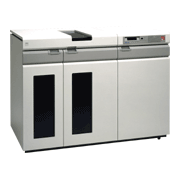This was Fujitsu's first Japanese language line printer (line printer for Japanese language processing) to employ laser-based xerography. Previous line printers, which were type-based impact printers, and the printable characters were limited to alphanumeric characters and katakana. Also, an expensive dedicated system was needed to print material containing kanji (Chinese characters). In March 1980, Fujitsu completed the No. 1 unit of the FACOM 6715D, a non-impact Japanese language line printer employing "Fujitsu Japanese Processing Extended Feature (JEF)" (announced in 1979). The JEF was an architecture which made it possible to handle the Japanese language in a standardized fashion. This printer had the following features:
- 1) It enabled high-quality printing by combining xerographic recording with a laser optics system having a simple structure and good printing precision.
- 2) A laser printer could achieve printing speeds of a few thousand lines per minute. This printer focused less on increasing printing speed, but more on ease-of-use, compactness and early dissemination of JEF. Thus it was designed with a speed of 2,000 lines per minute for optimal cost performance. (The price was somewhat higher than that of conventional equipment for alphanumeric/kana printing.)
- 3) The printer provided an optional "form overlay" function and various support utilities for printing forms overlaid on printing data, so various forms could be produced using the same type of paper.
- 4) It used the flash fixation system.
Instead of using the conventional hot roller fixation system (where the equipment fuses a toner image transferred onto paper by a heated roller), this printer used a new "flash fixation system" developed by Fujitsu. With this system, it is possible to use various types of printing paper, even sticker paper, because there is no direct contact with the paper. - 5) Because it used JEF (which was an extension of previous alphanumeric/kana specifications) the printer had both compatibility with previous printers, and expandability.
- 6) The printer made it possible to use flexible character sets. This was achieved by providing JIS Level 1, JIS Non-Kanji and alphanumeric/symbols/kana (Japanese kana) as basic character types, and loading other character types into the character generation mechanism using a floppy disk (optional) or software.
Various other models, following to the FACOM 6715D, were added later, including the low-end FACOM 6716D (1981, 1,000line/min), high-end FACOM 6700D (1982, 10,600line/min) and FUJITSU 6712E (1990, 5,000line/min), and they constituted a series. Other functional improvements such as image data printing were also added with the adoption of the JEFII architecture (FACOM 6715E, 1983, 2,000 lines per minute).
| FACOM 6716D | FACOM 6715D | F6712E | FACOM 6700D | ||
|---|---|---|---|---|---|
| Completion date | July 1981 | March 1980 | December 1990 | February 1983 | |
| Printing system | Laser-based xerography | ||||
| Printing speed | 12 line/inch | - | - | 10,100 line /min |
21,200 line /min |
| 8 line/inch | 1,330 line /min |
2,670 line /min |
6,700 line /min |
14,100 line /min |
|
| 6 line/inch | 1,000 line /min |
2,000 line /min |
5,000 line /min |
10,600 line /min |
|
| Line spacing | 1/6 inch,1/8 inch | 1/6 inch,1/8 inch, 1/12 inch (alphanumeric/kana) |
|||
| Number of characters printed per line | 136 char (alphanumeric/kana), 109 char (kanji (Chinese characters), approx. 9 point size),68 char (kanji (Chinese characters), approx. 12 point size) |
||||
| Resolution | Both vertical and horizontal: 240 dot/inch | ||||
| Character composition | Alphanumeric/Kana: 24×30 dot,Kanji (Chinese characters): 30×30 dot | ||||
| Character generation mechanism | Basic | Alphanumeric/Kana 109 char | Alphanumeric/Kana 255 char (20sets) | ||
| Optional | JIS Level 1 and JIS Non-Kanji (3,418 char) | ||||
| Loadable character types | Max. 8,192 char | Max. 14,336 char | |||
| Capable of pattern loading from host computer | |||||
| Format printing | optional (form overlay mechanism) | ||||
| Table generation and diagram printing | Possible by combining patterns | Diagram printing function, Image printing function |
Possible by combining patterns | ||
| Main connected models | FACOM M Series | ||||



